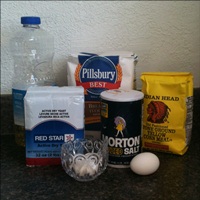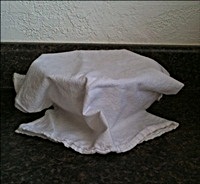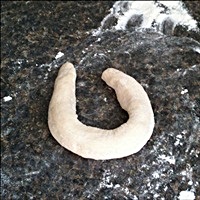Bagel Recipe - How to Make Bagels Step-by-Step Instructions

Homemade Bagel Recipe
I am no chef and I would like to start by letting you know a little bit about me. I am an avid baker and risk taker in the kitchen. I have been known to make some real masterpieces and am also known to have dumped an entire batch of something in the garbage because I tried a few too many spices in the same dish.
I am by no means a professional baker, cook or chef. My passion for baking and cooking happened gradually over the years and I have learned most of what I know about cooking from family members along with trial and error.
My knowledge of cooking also increased with the addition all those great cooking shows on TV. However, my basic skills where acquired from the 'elders' in my family. You know, those cooks who made the best Sunday dinners ever, the ones who could turn plain carrots into a gourmet meal? Well, they are the women and men that inspired me to become a better cook and baker.
Hopefully you have had a chance to read my 'Which Flour is best for your recipe' wherein I expressed my true love for baking breads and bagels. Why you ask? I have no idea! It may be because it was a challenge that I was able to conquer. Or it might just be the satisfaction that I don't have to go to the store or bakery to get my bread or bagels. Or it could be the surprised look or that attention grabber when I say, "Oh I make all my own breads". Whatever the reason, I just love it.
I have been improving and tweaking my bagel recipe for a very long time now. This recipe is the one that I think is the easiest with the fewest ingredients. I am going to share it with you along with a visual of the step-by-step instructions.
Ingredients
- 2 teaspoons active dry yeast
- 2 teaspoons white sugar
- 2/3 cups hot water
- 1 1/2 teaspoon vegetable oil
- 2 cups bread flour
- 1/2 teaspoon salt
- cornmeal for dusting
- 1 egg for wash

Let's Get Started
Combine hot water, sugar and yeast in a glass bowl. Stir ingredients with a fork, then cover with a towel.

Cover Yeast
Cover the wet yeast mixture with a towel and let stand for 10 or 15 minutes.
Note: I only use flour sack towels. I find that because they have such a tight thread weave that they really hold in the warmth so your yeast rises and you also don't get fuzzies in your dough that might get stuck on a regular dish towel.

Bubbled Wet Ingredients
The yeast, sugar and water mixture will have expanded in size and be bubbled when it's finished resting.

Add Oil to Wet Ingredients
Add the oil to the wet ingredients and blend it in well with a fork.
Note: This is an important step! If you try to add the oil after you have added the flour, you will have a sticky mess to work with. It will also be difficult to incorporate all the flour.

Add Dry Ingredients
Measure out the flour and put in the salt. Gradually add the flour and salt mixture to the wet mixture, mixing it in with a fork. When you can no longer mix it with a fork, get your hands in there and work it all together!
Note: Make sure that the salt is pre-mixed with the flour before you put it in the wet mixture. SALT should never directly touch yeast.

Prepare Your Workspace
Lightly flour your work surface. Put your dough on your work surface and knead it for approximately 7-8 minutes.
Note: Don't let the 'kneading' part scare you away. Knead the dough by flattening or rolling out your dough, grip the sides, flip them inward, press them down, flap the top downward and bottom upward, press down, and then go to the sides again. Repeat several more times and that's it.

Cover Your Dough
When you have finished kneading your dough, roll it into a large ball, put it back in the glass bowl and cover it with your towel.
Let the dough stand for 30 to 40 minutes while it rises.
Note: Do not disturb during this process.

Prep Your Cookie Sheet
While your dough is rising (resting), take a cookie sheet and lightly coat it with cornmeal.
Note: The cornmeal is necessary in order to keep your bagels from sticking while baking.

After it Rises
After 30 to 40 minutes of resting, your dough will have almost doubled in size.
Punch down the dough, (which means, poke a whole to release the air) and fold it out onto your lightly floured work surface.

Divide Your Dough
Depending on the size of the bagels you want to make, divide the dough into into 6 to 8 equally sized pieces.
There are a few different ways to form your bagels.
One way is to roll out balls and slightly flatten them, then place them on the cornmeal dusted cookie sheet.
Note: The bagel 'hole' part comes later right before parboiling.

Start Your Bagel
The standard way to make a bagel shape is to roll out an approximately 8" inch tube or snake shape.

Shape Your Bagel
Take the 8" snake and then loop it so that it forms a ring. Bring both ends together and pinch to join it.
Some people add a little knot at the end by folding one end of the dough over the other end and tucking the ends under.
Put a very small amount of water at the joined area to seal the dough.

Place on Cookie Sheet
Place the shaped bagels on the cornmeal dusted cookie sheet.
Here are both the ring style and the ball style.
The ring style are your basic bagels.
To make the hole in the ball or flattened style, poke a hole down in the center of the dough with your thumb and tuck it under the bottom of the ball. You can do this before you let them rise again or before you parboil them.

Second Rise
Cover the bagels with your towel and let stand for 30 to 40 minutes.
The bagels will once again almost double in size.
Note: After your bagels have set for approximately 20 minutes, fill a frying pan with water, 1/2 full, and begin to boil.

Start the Parboil
If you did not poke the hole in the ball style bagels yet, do that now.
Now that your bagels have set, and all have holes, carefully take them from your cookie sheet and parboil each for 1 1/2 to 2 minutes on each side.
Note: Parboiling is between a full boil and a simmer. The bagels will be slippery so I use a slotted spatula and a wooden spoon while handling the bagels.

Dry Bagels
When each bagel has been parboiled on both sides, carefully remove the bagels from the water and place them on the towel. Gently pat dry each bagel on both sides.
Note: For crustier bagels, put a small metal baking pan filled with water on the bottom of your oven. The steam will help crisp up the outside of your bagels.
Put your oven rack on the lowest setting and preheat your oven to 400*.

Put Bagels on Cookie Sheet
Place the dried bagels back onto your cornmeal dusted cookie sheet.
Lightly egg wash each bagel.
Note: My egg wash is a really well whisked egg with just a TAD of water.
Place the baking sheet on the bottom rack of the oven for 15 to 25 minutes or until the top of your bagels are medium golden brown on top.

Bon Appetite!
The finished product speaks for itself.
As you can see, the rolled snake method (the two bagels in the front) are not that much different than the ball and thumb method (the two bagels in the back). The bagels in the center are preferred by my grandson, no hole at all!
Enjoy.

© 2012 Irenevosburgh








